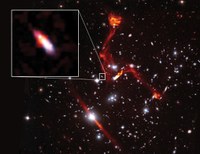The Faintest High Redshift Star-forming Galaxy
 The Jansky Very Large Array has performed ultra-deep (1micro-Jy rms), high-resolution (< 0.6 arcsec) imaging of the Hubble Space Telescope cluster-lensed Frontier fields. These observations reveal hundreds of distant star-forming galaxies, from which the authors derive star formation rates and source sizes, unbiased by dust obscuration.
The Jansky Very Large Array has performed ultra-deep (1micro-Jy rms), high-resolution (< 0.6 arcsec) imaging of the Hubble Space Telescope cluster-lensed Frontier fields. These observations reveal hundreds of distant star-forming galaxies, from which the authors derive star formation rates and source sizes, unbiased by dust obscuration.
The faintest reliably identified radio source corresponds to a galaxy at z ~ 1, with a star formation rate of only 10 M⊙/yr, making it the faintest high-redshift star-forming galaxy detected to date in the radio continuum.
The observations of strongly-lensed fields provide important information for planning future deep fields with the Square Kilometre Array and the next generation Very Large Array.
Image Caption: Composite Very Large Array (3 GHz) and Hubble Space Telescope image, of the Frontier field MACSJ0717.5+3745 at 0.6 arcsec resolution. The large diffuse structures are radio relics and jets in the lensing cluster. The faintest source (inset) corresponds to a de-magnified flux density of 0.9 micro-Jy and is a star-forming galaxy at z ~ 1.
Publication 1: Ian Heywood (Oxford University, Rhodes University, South African Radio Astronomy Observatory) et al., The VLA Frontier Fields Survey: Deep, High-resolution Radio Imaging of the MACS Lensing Clusters at 3 and 6 GHz, Astrophysical Journal, 910, 105 (April 2021).
Publication 2: E.F. Jiménez-Andrade (NRAO) et al. The VLA Frontier Field Survey: A Comparison of the Radio and UV/Optical Size of 0.3 ≲ z ≲ 3 Star-forming Galaxies, Astrophysical Journal, 910, 106 (April 2021).
NRAO Press Release: IMAGE RELEASE: Cosmic Lens Reveals Faint Radio Galaxy




Connect with NRAO